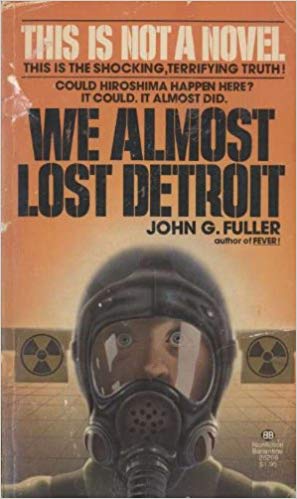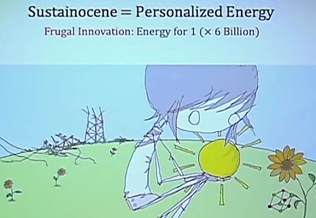A prototype for how NOT to do energy [reviewer’s subtitle]
By John Fuller (1913-1990)
 The motivation to read this book arose from simply the fact that I had heard the book title so many times, I live in the Detroit area, and now work part time where sometimes my route takes me to Monroe, Michigan, where the Fermi plant was built on (in 1966 called) Lagoona Beach of Lake Erie. The book was written in 1975 and reads like a thriller… though as it states on the cover in the form of a subtitle: This Is Not a Novel.
The motivation to read this book arose from simply the fact that I had heard the book title so many times, I live in the Detroit area, and now work part time where sometimes my route takes me to Monroe, Michigan, where the Fermi plant was built on (in 1966 called) Lagoona Beach of Lake Erie. The book was written in 1975 and reads like a thriller… though as it states on the cover in the form of a subtitle: This Is Not a Novel.
I wanted to get the inside skinny on whether or not the title is true. My conclusion is that, yes, on October 5, 1966, in development since 1953, the Enrico Fermi liquid-sodium-cooled fast-breeder nuclear power plant (Fermi 1) experienced a meltdown of some fuel assemblies. At the time of the incident it was unknown how many fuel elements had melted and whether a secondary accident of catastrophic proportions—meltdown of the core, subsequent explosion, violation of containment, and dispersion of radioactive plumes covering 10s of thousands of square miles (including metro Detroit some 50 miles from the site)—was imminent.
You can skip to Chapter 12 thru the epilogue to get the short story of what happened during the early days of October 1966, then subsequently as teams tried to determine what exactly had happened while trying to reach a stable condition where the threat of secondary meltdown was rendered minimal. They were able with extreme, tedious effort to remove the damaged subassemblies by May 1967, then it took another several months to determine the fundamental cause of the overheating: some flow shielding that had come loose and prevented coolant flow to those sections of the core.
About two years later, Autumn 1968, the debris had been cleaned up and estimates for resurrection of an operable reactor were a year and a half down the road. By May 1970 Fermi 1 was nearly ready to resume operation, then in July 1970 the reactor was fired up and, in October 1970, four years after the incident, Fermi reached its designed 200,000 Kilowatt power rating. License renewal loomed in January 1971, the AEC reluctantly did so. But the public was voicing increasing concerns, and Detroit Edison was looking at Fermi increasingly as a major load on its bottom line:
“To keep the plant on its feet, Detroit Edison was paying the AEC $65,000 a month for the use of the uranium fuel. The amount of electricity produced since Fermi began operations was practically nothing. Even running at its capacity, the power produced would cost up to 15 times as much as coal. Its only raison d’etre, therefore, was that of a demonstration plant. Even so, it was doing very little demonstrating. The costs for the project had now edged up to $132 million…”
Fermi 1 was decommissioned November 29, 1972.
Another virtue of We Almost Lost Detroit is that author Fuller covers so much of the relatively unspoken background of eff ups in the industry: particularly incidents at the less complex test reactors at Idaho Falls, Idaho, or Windscale (Seascale, England), or Chalk River, Ontario. Fuller describes the gory details, and how the health and well-being of the general population affected—or might have been affected—are steamrolled by the pertinent industry-government alliances that lie, lie, and lie… to keep their lucrative crap game afloat. A game where the people not only suffer the consequences of their mal-feasance but also are obliged to produce the tax funds to pay for it all.
Fuller also cites the various studies up til that time that presented the “maximum credible accident” event—WASH-740, Brookhaven National Labs, University of Michigan. Yes, they were dealing with more unknowns, and didn’t have the computer power to assess probabilities as well. But the raw facts still apply: “And while the problems with the light-water reactors were different from those of the sodium-cooled breeder, they were just as serious. If a major pipe broke, and if the cooling water was lost, there could be a catastrophe. There wasn’t a nuclear engineer in the business who would deny it.”
The projections of these early studies were horrific,[1] and almost brings back that feeling of naivete many of us had, for the old days, when you might actually receive honest answers from academics. Though many conclusions were not released to the public. Later reports and studies have become much more sophisticated and polished, putting nuclear fission reactors back into the “clean, safe, too cheap to measure” category. Modern mainstream journalists are firmly embedded in the industries they cover, their hard-nosed stories are drawn from utility monopoly Websites and news releases.
The Last Word
The derivative, yet ironclad proof that conventional nuclear power is unsafe—true for any product or technology the toxocracy wishes to foist upon the general public: vaccines, 5G wireless cellular, ‘smart’ meters, GMOs, contaminant spraying and heating of the atmosphere, offshore oil drilling, fracking, etc.—is nobody will credibly insure it or fix the damage.
In the case of nuclear fission plants, the federal government imposed the Price-Anderson Act limiting liability for any nuclear accident to some artificially low number ($560 million) $500 million of which the taxpayers have to cough up, anyway.
“Those who supported the atomic energy program argued that without this government subsidized insurance (Price-Anderson limitation of government-corporate liability to $560 million), not a single reactor would be built by private industry. The counterargument was that if the reactor builders and operators didn’t have enough confidence in the safety of the atomic plants to assume responsibility for the risks, they shouldn’t be building them at all.” — page 64
John Fuller writes in a “You Were There” style that is compelling. More so because the subject matter is so explosive. He points out that several of the leading national magazines and newspapers were forming a consensus in 1975 that:
- The shutdown of nearly half of the power reactors in the country for a second time in six months was making investors nervous.
- Construction delays at roughly 100 plants all over the country were clouding the industry’s future.
- Costs of the planned Clinch River, Tennessee, demonstration breeder plant had jumped from $700 million to $1.7 billion.
- The vulnerability of nuclear plants to earthquakes had not been solved.
- Emergency core cooling systems for light-water reactors still remained untested.
- Thousands of kilograms of plutonium are unaccounted for, some of which might be missing from government inventories.
- At least three new congressional hearings on nuclear safety were scheduled in 1975.
- A referendum was being prepared in California to prohibit the building of nuclear power plants in that state.
- Belgium, France, and Sweden are all limiting nuclear power plants in one form or another.
There was also a growing consensus that fission plants must be stopped, that we rely on clean coal in the transition to meet major energy needs, conservation is essential, funds going into fission power plants should be channeled into accelerated development of thermonuclear fusion, more intensive research and development is needed for alternative sources of energy, and build a crash and long-term program for solar energy.
1975, that’s 43 years ago. Where are we now wrt fission reactors? From a Union of Concerned Scientists article: “By the 1980s, the nuclear industry was in serious trouble. No new plants were ordered after 1978, and all those ordered since 1973 were later canceled. Forbes magazine reported in 1985 that a sample of 35 plants then under construction were expected to cost six to eight times their original price estimate, and to take twice as long to build as planned—from six years to twelve.”
“Remaining anomynous, an engineer at the Fermi project analyzed the [1966] accident: ‘Let’s face it, we almost lost Detroit.'” A remarkable watershed book. The way I read the tea leaves, ALL nuclear reactors must be carefully brought down, decommissioned, and ‘cleaned up’… and that we’re living with an incomprehensibly devastating time bomb around each of them until they are.
 The future of energy, IMHO, lies in what Dan Nocera calls the Sustainocene Era. Fusion is still possible, but I think Dr. Nocera has the ultimate mousetrap:
The future of energy, IMHO, lies in what Dan Nocera calls the Sustainocene Era. Fusion is still possible, but I think Dr. Nocera has the ultimate mousetrap:
http://bit.ly/2KZOKUI_Dan_Nocera_TED_2013
And we are very close. 🙂
[1] The Brookhaven studies of the mid 1960s showed that a meltdown ‘maximum credible accident’ would produce 27,000 deaths, 73,000 injuries, and $17 billion in property damage in the near term. Extremely toxic and deadly radioactive byproducts would continue to contaminate tens of thousands of square miles for hundreds of years.
This post has been read 4288 times!

